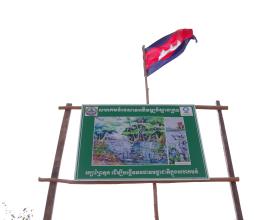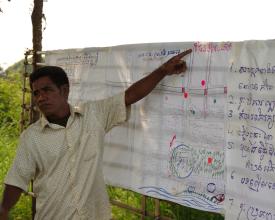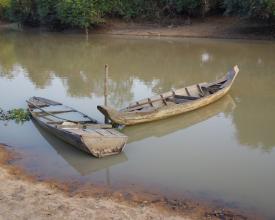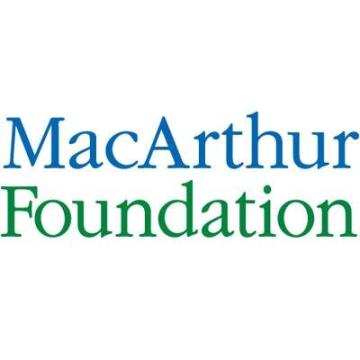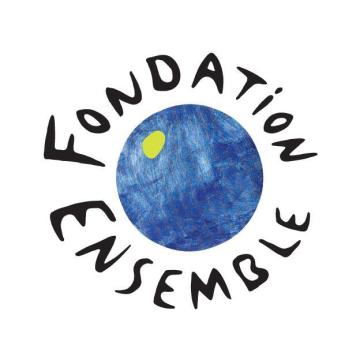Renforcer la capacité des communautés à gérer les pêcheries d'eau douce au Cambodge
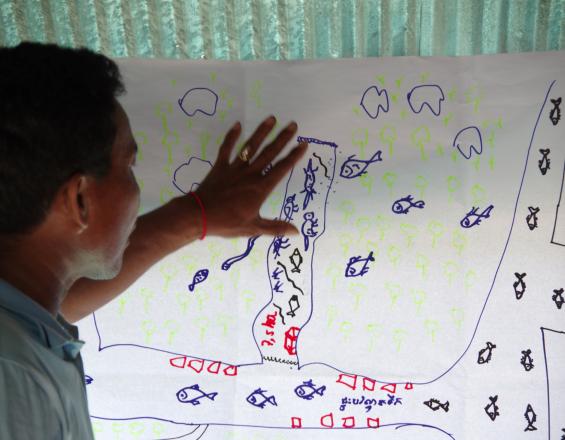
Le Cambodge abrite l'une des plus grandes pêcheries intérieures du monde. Centrée autour du lac Tonle Sap et du Mékong, la pêche fournit de la nourriture et des moyens de subsistance à des millions de personnes. Une grande partie de cette ressource commune est gérée par des organisations communautaires de pêche (OCP) - des pêcheurs locaux mandatés par le gouvernement pour gérer leur zone locale dans l'intérêt de leurs ressources halieutiques. Malheureusement, les pêcheurs cambodgiens font partie des personnes les plus pauvres et les plus marginalisées du pays. Et la majorité des communautés de pêcheurs cambodgiennes sont dysfonctionnelles. La mise en place de CFi fonctionnelles nécessite un important renforcement des capacités communautaires, car les CFi sont confrontées à des problèmes d'enregistrement auprès du gouvernement, de capacité organisationnelle, d'alphabétisation financière, de planification et de mise en œuvre. L'approche de Conservation International en matière de renforcement des capacités communautaires aborde ces questions et nous avons réussi à établir un partenariat avec quatorze CFi qui gèrent activement leurs ressources halieutiques locales.
Contexte
Défis à relever
La plupart des organisations communautaires de pêche au Cambodge manquent de ressources et ne sont pas en mesure de gérer correctement leurs ressources halieutiques locales. Parmi les défis à relever, citons la destruction des forêts inondées et des zones arbustives pour l'agriculture, les incendies allumés délibérément et la pêche illégale et excessive. Le changement climatique et le développement de l'hydroélectricité en amont modifient les régimes d'écoulement naturels, ce qui menace encore davantage la pêche. Le changement climatique se traduit également par des saisons sèches plus longues et plus chaudes et des saisons humides plus courtes mais plus intenses. La plupart des communautés lacustres n'ont que peu ou pas de moyens de gérer leurs ressources naturelles ou de s'adapter à ces changements, qui ne cessent de dégrader leurs moyens de subsistance.
Emplacement
Traiter
Résumé du processus
Les quatre modules sont complémentaires. Bloc 1 - L'analyse SWOT et l'analyse de la situation déterminent les communautés appropriées et révèlent des informations sur lesquelles s'appuient les blocs suivants. Bloc 2 - La liaison avec le gouvernement interagit avec le bloc 1, car le soutien des autorités locales est essentiel à la réussite à long terme de l'initiative communautaire. Les capacités sont ensuite renforcées dans ces deux blocs par le bloc 3 - cartographie des ressources communautaires et le bloc 4 - formation du comité de l'ICF. Ces blocs permettent aux communautés de pêcheurs d'acquérir les connaissances et les compétences structurées nécessaires pour gérer avec succès leurs ressources halieutiques.
Blocs de construction
Liaison avec le gouvernement
Comme les pêcheries communautaires opèrent sous mandat gouvernemental, l'engagement des autorités locales - en particulier l'administration des pêcheries du canton et les responsables de la commune - est essentiel au succès de tout engagement avec une PCi. Les autorités locales doivent comprendre et soutenir l'engagement de Conservation International auprès d'une PFC. Tout d'abord, nous rencontrons l'administration des pêches aux niveaux national et local, afin de présenter notre programme et d'identifier les bénéficiaires potentiels. Ces réunions permettent d'établir des relations avec les hauts fonctionnaires du gouvernement et d'obtenir des informations telles que les contacts locaux au sein des communautés de pêcheurs potentielles. Après avoir obtenu un soutien de haut niveau, nous contactons les autorités locales telles que la commune et, en les informant de notre approche, nous obtenons une appréciation de la situation actuelle de chaque FCI, des défis qu'elle doit relever et des opportunités qu'elle doit saisir.
Facteurs favorables
La première étape essentielle consiste à obtenir le soutien des hauts fonctionnaires. La participation des autorités locales est ensuite requise, car elles participent au processus de planification et fournissent une reconnaissance officielle des documents juridiques associés au développement de l'ICF. Dans l'idéal, l'équipe de mise en œuvre peut s'appuyer sur les liens établis avec les autorités locales compétentes. Toutefois, elle doit comprendre le contexte dans lequel ces autorités locales opèrent et la manière dont les activités de développement de l'ACEF renforcent les rôles et les responsabilités des autorités locales. Ce processus doit être mené par des responsables de projet expérimentés en matière de relations avec les pouvoirs publics.
Leçon apprise
Il est important de s'engager rapidement auprès des autorités locales, car leur participation est cruciale pour le succès de tout engagement avec une ACEF. Elles fourniront également à l'équipe de projet des informations supplémentaires sur les capacités des CFI et augmenteront les chances de réussite de l'engagement avec un CFI.
Analyse SWOT, de la situation et de la vulnérabilité climatique
Une analyse de la situation fournit des informations de base sur lesquelles se fondent les efforts de renforcement des capacités de la communauté. Tout d'abord, nous réalisons une analyse SWOT rapide d'une pêcherie communautaire (CFi) et de la communauté qui lui est associée. L'analyse SWOT rassemble des informations de base sur chaque communauté et examine la structure et la fonction de la PCP. Les forces, les faiblesses, les opportunités et les menaces auxquelles est confrontée chaque communauté sont abordées lors d'une discussion de groupe entre l'équipe de mise en œuvre et un petit nombre de représentants de la communauté. L'analyse de la vulnérabilité climatique permet de dresser un tableau des défis propres à chaque communauté en matière de changement climatique, en particulier ceux qui sont associés à leurs aires communautaires de conservation du poisson.
Nous utilisons l'analyse SWOT pour déterminer si une communauté peut faire l'objet d'un engagement plus poussé et, dans l'affirmative, nous effectuons une analyse de situation détaillée qui approfondit les caractéristiques et les défis de l'ICP. Cela nous permet de décider si nous allons nous associer à une communauté et, si c'est le cas, les résultats nous aident à développer une approche appropriée pour travailler avec elle. L'analyse de la situation est également utilisée pour déterminer l'implication des femmes dans les pêcheries communautaires - nous nous appuyons ensuite sur ces informations pour accroître leur participation au fur et à mesure que nous mettons en œuvre d'autres éléments de base. L'analyse de la vulnérabilité climatique est l'étape finale de notre partenariat avec une communauté.
Facteurs favorables
L'équipe de mise en œuvre doit être familiarisée avec le contexte de la pêche communautaire et formée à l'analyse SWOT et à l'analyse de la situation. Il est également nécessaire d'instaurer un climat de confiance avec la communauté.
Leçon apprise
Des décisions importantes sont prises à trois étapes : 1) décider des communautés à évaluer initialement et effectuer une analyse SWOT ; 2) utiliser les résultats de l'analyse SWOT pour classer les communautés par ordre de priorité en vue d'une évaluation plus approfondie via l'analyse complète de la situation ; et 3) utiliser les résultats de l'analyse de la situation pour décider des communautés avec lesquelles établir un partenariat pour le renforcement des capacités et la mise en œuvre de l'analyse de la vulnérabilité au changement climatique.
Ressources
Cartographie des ressources communautaires
La co-création d'une carte des atouts de la communauté et des ressources naturelles prépare le terrain pour le renforcement des capacités de la communauté. Une carte des ressources de la communauté décrit à la fois les caractéristiques naturelles (cours d'eau, étangs, rizières, etc.) et l'infrastructure physique. La cartographie des ressources permet d'apprendre comment les villageois gèrent, conservent et utilisent leurs ressources naturelles. La carte des ressources de la communauté doit être élaborée par au moins 10 membres compétents de la communauté, dont les membres du comité de gestion et de la CFi, les femmes, les anciens et les autorités locales. Avec l'aide de l'équipe de projet, un membre de la communauté bien informé rédige la carte. Avant d'être représentée, la localisation des éléments importants doit être discutée et confirmée par les autres participants. La carte doit également représenter toutes les zones officielles (par exemple, les zones de pêche communautaires ou les zones de conservation des poissons communautaires) ou discuter des zones potentielles de zonage.
Une discussion de groupe suit l'achèvement de la carte afin de déterminer la dépendance et l'interaction des populations avec leurs ressources naturelles, ainsi que les principaux défis en matière de gestion et de conservation. Cela nous permet de trouver des domaines d'amélioration en matière de développement communautaire, de gestion des ressources naturelles et de conservation.
Facteurs favorables
Une communauté suffisamment motivée est nécessaire pour élaborer une carte des ressources communautaires précise et informative. L'équipe du projet doit avoir de l'expérience dans l'animation de discussions au sein de groupes communautaires et dans l'élaboration de cartes de ressources communautaires. L'équipe doit également s'assurer que les femmes sont impliquées dans les discussions et que les réunions sont organisées à des heures qui leur permettent d'y assister.
Leçon apprise
Le défi le plus courant auquel sont confrontées les communautés de pêcheurs est la gestion de leurs refuges de poissons pendant la saison sèche. Nombre de ces étangs sont déconnectés du lac pendant la saison sèche et risquent de s'assécher à mesure que le changement climatique entraîne des conditions plus chaudes pendant la saison sèche. Nos partenaires communautaires ont suggéré d'augmenter la profondeur de ces zones humides et de créer des connexions permanentes avec le lac afin de s'assurer qu'elles restent pleines pendant la saison sèche et de protéger ainsi les poissons qui s'y abritent jusqu'à ce que le lac soit à nouveau inondé. Un autre défi auquel sont confrontées de nombreuses communautés est la difficulté de gérer des zones de conservation éloignées. Il en résulte souvent la création de nouvelles zones de conservation plus proches des villages locaux, ce qui permet une gestion plus étroite et plus efficace.
Formation du comité communautaire de la pêche
La gestion communautaire des pêches est complexe et chaque comité CFi doit convoquer et enregistrer des réunions, organiser des élections, faire preuve de transparence financière et rendre des comptes. Le comité doit également avoir les compétences nécessaires pour travailler avec les autorités locales et comprendre le cadre juridique dans lequel il opère. Nous fournissons ces compétences en dispensant des modules de formation sur les procédures de réunion, la gestion des comités, la loi sur la pêche, le genre dans la gestion des ressources naturelles, la protection de l'environnement, la rédaction de propositions et de rapports, et la gestion du budget.
Facteurs favorables
Le comité CFi doit être correctement structuré et actif avant de pouvoir être formé à la procédure de réunion, à la gestion du comité, à la loi sur la pêche, au genre dans la GRN, à la protection de l'environnement, à la rédaction de propositions et de rapports, et à la gestion financière. Les formateurs doivent avoir l'expérience de la formation des villageois locaux et du matériel de formation. L'équipe du projet doit s'assurer que les femmes sont impliquées dans les discussions et que les réunions se tiennent à des heures qui leur permettent d'y assister.
Leçon apprise
Le renforcement des capacités de gestion des comités communautaires de pêche les aide non seulement à gérer leurs ressources halieutiques, mais aussi à instaurer un climat de confiance avec leurs membres, les donateurs, les autorités locales et l'administration des pêches. Notre formation a permis aux comités CFi de présenter leur travail aux donateurs et aux responsables de la commune et de l'administration des pêches. Les comités CFi sont désormais en mesure d'aligner leurs plans de travail sur la stratégie d'investissement de leur commune. La formation sur le genre dans la GRN a amélioré l'égalité entre les hommes et les femmes dans l'accès et la gestion de leurs ressources naturelles.
Impacts
Nous avons appliqué notre approche à quatorze organisations communautaires de pêche au Cambodge. Chacune d'entre elles est reconnue par le gouvernement royal cambodgien et leurs comités actifs mettent en œuvre leurs plans de gestion. Le renforcement des capacités de ces organisations a bénéficié directement aux 7347 membres des quatorze CFi (dont 3856 femmes). Les communautés gèrent 43 470 ha d'habitat piscicole, comprenant des eaux libres, des forêts inondées et des zones arbustives, des rizières et des étangs de refuge pour les poissons de la saison sèche. Cela a permis à nos communautés partenaires de gérer leur CFi de manière cohérente en effectuant des patrouilles pour détecter les activités de pêche illégales - souvent en collaboration avec les fonctionnaires de l'administration des pêches - en assurant une protection 24 heures sur 24 de leurs étangs de refuge pendant la saison sèche, en répondant à la menace des incendies de forêt et en organisant des sessions d'éducation pour les membres de la CFi et les pêcheurs saisonniers sur leurs droits et leurs responsabilités en vertu de la loi sur la pêche. Nos communautés partenaires ont également commencé à restaurer plus de 500 hectares de forêts inondées. Elles ont également tissé des liens étroits avec les autorités locales et régionales.
Bénéficiaires
Les membres des organisations communautaires de pêche et leurs familles bénéficient d'une meilleure gestion de la pêche. Environ 300 espèces de poissons et leur habitat de plaine inondable sont préservés, ainsi que de nombreux oiseaux, mammifères et reptiles menacés figurant sur la liste rouge de l'UICN.
Objectifs de développement durable
Histoire
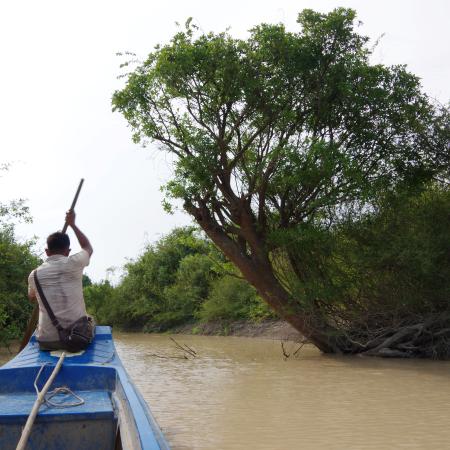
Lorsque Conservation International a commencé à travailler avec les communautés de pêcheurs sur le lac Tonle Sap en 2010, les villageois se sont interrogés sur la manière dont notre travail de conservation affecterait l'accès à la pêche. Au cours de nombreuses réunions, nous avons discuté de nos objectifs de conservation et de la façon dont ils pourraient aider leurs moyens de subsistance. L'analyse de la situation de notre solution nous permet de comprendre leur situation, ce que nous avons suivi par une formation approfondie et un renforcement des capacités. Grâce à cela, ces communautés ont vu les avantages du travail de conservation et ont modifié leurs pratiques pour protéger leurs ressources.
Par exemple, lorsque nous avons commencé à travailler avec Srey Chek Community Fishery (CFi) en 2015, leur comité de gestion CFi était inactif et les membres de la communauté nous ont dit que leurs ressources halieutiques étaient en déclin en raison de la surexploitation et de la pêche illégale rampante dans leur zone CFi. Grâce à la mise en œuvre des mesures décrites dans cette solution, la CFi de Srey Chek dispose d'un comité de gestion fort et engagé, soutenu par les membres de la CFi et les autorités locales du village jusqu'au niveau provincial. Ce soutien se traduit par une participation active aux activités et au financement du CFi. Le comité de la CFi effectue désormais des patrouilles régulières dans la zone de la CFi, souvent accompagné par des fonctionnaires de l'administration des pêches et des autorités locales, qui sont légalement autorisés à avertir les pêcheurs illégaux, à leur infliger des amendes et à retirer les engins de pêche illégaux. Les membres du comité CFi de Srey Chek ne protègent pas seulement leur zone communautaire de conservation des poissons, mais ils aident également l'administration des pêches à surveiller le sanctuaire de poissons de l'État situé à proximité, en signalant les activités illégales directement au gouverneur de la province. Le comité CFi a également relâché dans sa zone communautaire de conservation du poisson des poissons tels que le barbeau géant(Catlocarpio siamensis), gravement menacé d'extinction, et des animaux sauvages tels que des pythons et des tortues reçus de la part des membres du comité CFi et des autorités locales.


